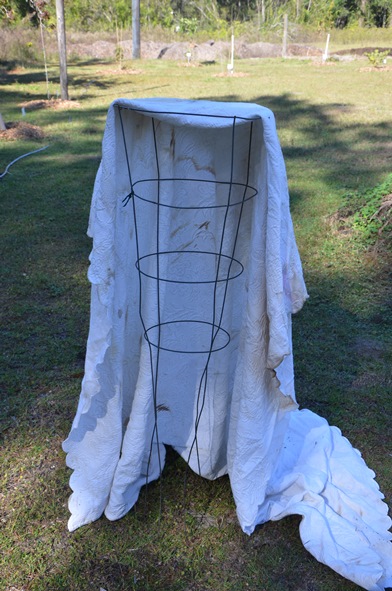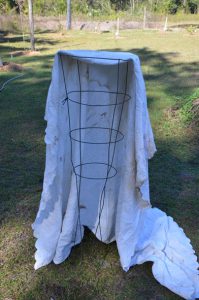
Winter Shrubs

Photo Caption: Unused tomato cages are a perfect support for heavy covers which can protect delicate landscape shrubs during the frosts of winter. When spring arrives, they can again be used to support tomato plants. Image Credit Les Harrison
The Thanksgiving turkey is but a distant memory, the stores are stocking for the spring, and Christmas decorations are coming down.
The advent of the new year, finally brings the inevitability of cold and frosty weather. While nothing complements a nice eggnog or hot chocolate like a chill in the air, some northwest Florida landscape plants do not appreciate the dropping temperatures.
Gardeners face a new set of challenges dealing with the effects of cold weather. However, a little planning and creativity can make plant protection in the landscape a relatively simple process.
Many homeowners and landscape managers want to know when plants will need protection. Depending on the plant, the point of freezing is a good rule of thumb. Freezes will likely occur this season so preparations should begin now.
It is worth noting there is a difference in the terms used for cold weather conditions. Frost, freeze and hard freeze all describe different circumstances.
Frost is when water vapour freezes on surfaces. It usually happens on clear nights with still air and can happen when reported air temperatures are above freezing.
Freezing is when cold air moves in and causes temperatures to drop below 32 degrees Fahrenheit. This condition commonly involves low humidity and wind, making drying out a big problem for plants.
A hard freeze is when temperatures dip below 28 degrees Fahrenheit. Some tropical plants will survive a few degrees below freezing for very short periods, but extended periods of freezing or heavy frost may require lights or other heat used safely in combination with covering the plant.
In the Panhandle, most of the risk for sustaining freeze damage happens during the busy holiday season. People are busy, schedules are disrupted and the distractions, pleasant thought they be, may cause homeowners to miss a critical freeze alert in the media.
Some plants can be moved indoors for the cold months and incorporated into the interior décor, rather than cramming them last-minute into a chaotic bundle when a freeze looms.
While putting away the holiday decorations into storage, identify old sheets, blankets and drop cloths which can be used as covers for tender plants which must remain outside. Test potential covers beforehand to assure all plants will be thoroughly covered.
It is best if the covers enclose the plant entirely without crushing it. Heavy blankets are great insulation, but only a good idea on the sturdiest of plants.
A tomato cage or other support structure can be used to keep the weight off the plant. Covers also need to be secured at the ground with pins or weights to assure cold air does not enter from below and collect under the cover.
Finally, keep storage bins handy and remove the covers in the daytime if temperatures are above 55 degrees Fahrenheit.
Monitor weather reports and react accordingly so your tender and tropical plants see spring 2018. Santa will approve.
